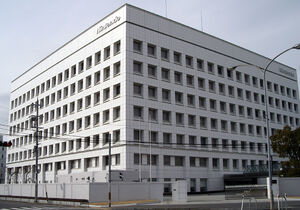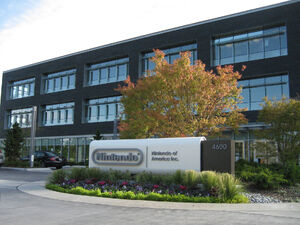from December 10, 2013 to January 10, 2014.

The exterior of Nintendo's main headquarters in Kyoto, Japan
Nintendo Co., Ltd. (任天堂株式会社 Nintendō Kabushiki gaisha) is a Japanese multinational consumer electronics company with headquarters in Kyoto, Japan. Nintendo is the world's largest video game company by revenue. Founded on September 23, 1889 [1] by Fusajiro Yamauchi, it originally produced handmade hanafuda cards.[2]
Abandoning previous ventures, Nintendo developed into a video game company, becoming one of the most influential in the industry and Japan's third most valuable listed company with a market value of over US$85 billion.[3]
As of June 30, 2013, Nintendo has sold over 655.9 million hardware units and 4.12 billion software units. [4]
Key executives
- Satoru Iwata, Global President, Representative Director, and CEO of Nintendo of America.
- Shigeru Miyamoto, Senior Managing Director and Representative Director
- Yoshihiro Mori, Senior Managing Director, General Manager of Corporate Analysis & Administration Division, and Representative Director
- Shinji Hatano, Senior Managing Director, General Manager of Licensing Division, and Representative Director
- Masaharu Matsumoto, Managing Director
- Tatsumi Kimishima, Managing Director
- Reggie Fils-Aime, President and COO of Nintendo of America (NoA)
- Satoru Shibata, President of Nintendo of Europe (NoE)
- Hideki Konno, development head of Nintendo EAD Software Development Group Number 1.
History
Nintendo was founded as a card company in late 1889, originally named Nintendo Koppai. Based in Kyoto, Japan, the business produced and marketed a playing card game called Hanafuda. The handmade cards soon became popular, and Yamauchi hired assistants to mass-produce cards to satisfy demand. Nintendo continues to manufacture playing cards in Japan[5] and organizes its own contract bridge tournament called the "Nintendo Cup."[6]
1956, Hiroshi Yamauchi, grandson of Fusajiro Yamauchi, visited the U.S. to talk with the United States Playing Card Company, the dominant playing card manufacturer there. He found that the world's biggest company in his business was only using a small office. This was a turning point when Yamauchi realized the limitations of the playing card business. He then gained access to Disney's characters and put them on the playing cards to drive sales. In 1963, Yamauchi renamed Nintendo Playing Card Co. Ltd. to Nintendo Co., Ltd.[7] The company then began to experiment in other areas of business using newly injected capital. During this period of time between 1963 and 1968, Nintendo set up a taxi company, a love hotel chain, a TV network, a food company (selling instant rice, similar to instant noodles) and several other things. All of these ventures eventually failed, and after the 1964 Tokyo Olympics, playing card sales dropped, and Nintendo's stock price plummeted to ¥60.
In 1966, Nintendo moved into the Japanese toy industry with the Ultra Hand, an extendable arm developed by its maintenance engineer Gunpei Yokoi in his free time. Yokoi was moved from maintenance to the new "Nintendo Games" department as a product developer. Nintendo continued to produce popular toys, including the Ultra Machine, Love Tester and the Kousenjuu series of light gun games. Despite some successful products, Nintendo struggled to meet the fast development and manufacturing turnaround required in the toy market, and fell behind the well-established companies such as Bandai and Tomy. In 1973, its focus shifted to family entertainment venues with the Laser Clay Shooting System, using the same light gun technology used in Nintendo's Kousenjuu series of toys, and set up in abandoned bowling alleys. Following some success, Nintendo developed several more light gun machines (such as the light gun shooter game Wild Gunman) for the emerging arcade scene. While the Laser Clay Shooting System ranges had to be shut down following excessive costs, Nintendo had found a new market.
Nintendo's first venture into the video gaming industry was securing rights to distribute the Magnavox Odyssey video game console in Japan in 1974. Nintendo began to produce its own hardware in 1977, with the Color TV Game home video game consoles. Four versions of these consoles were produced, each including variations of a single game (for example, Color TV Game 6 featured six versions of Light Tennis).
A student product developer named Shigeru Miyamoto was hired by Nintendo at this time[8]. He worked for Yokoi, and one of his first tasks was to design the casing for several of the Color TV Game consoles. Miyamoto went on to create, direct and produce some of Nintendo's most famous video games and become one of the most recognizable figures in the video game industry[9].
In 1975, Nintendo moved into the video arcade game industry with EVR Race, designed by their first game designer, Genyo Takeda,[10] and several more titles followed. Nintendo had some small success with this venture, but the release of Donkey Kong in 1981, designed by Shigeru Miyamoto, changed Nintendo's fortunes dramatically. The success of the game and many licensing opportunities (such as ports on the Atari 2600, Intellivision and ColecoVision) gave Nintendo a huge boost in profit and in addition, the game also introduced an early iteration of Super Mario, known then as Jumpman, the eventual mascot of the company. In 1980, Nintendo launched Game & Watch, a handheld video game series developed by Yokoi where each game was played on a separate device—to worldwide success.
Divisions

Nintendo of America headquarter
Nintendo Entertainment Analysis and Development
Nintendo Entertainment Analysis and Development (Nintendo EAD) is a division of Nintendo known for designing Super Mario games, although they have also worked on other series, such as The Legend of Zelda and Star Fox. The Chief Production Officer is Satoru Iwata, but the general managers are Shigeru Miyamoto and Takashi Tezuka.
Nintendo Software Technology Corporation
Nintendo Software Technology Corporation (often abbreviated to NST) is an American division of Nintendo based in Redmond. It also has ties to the NOA-backed Digipen Institute of Technology, from which it draws a plurality of its employees. The company developed the Mario vs. Donkey Kong series.
International Divisions
| Division | Company | Location | Corporate role | |
|---|---|---|---|---|
| Nintendo Co., Ltd. NCL |
East Asia | |||
| Nintendo Co., Ltd. | NCL | Kyoto, Japan Tokyo, Japan |
Parent company. Japan publishing, sales, marketing and distribution.[11] | |
| Nintendo (Hong Kong) Co., Ltd. | NHK | Hong Kong sales, marketing and distribution. | ||
| Nintendo of Korea Co. Ltd. | NOK | South Korea publishing, sales, marketing and distribution. | ||
| Nintendo Taiwan Co. Ltd. | Taiwan sales, marketing and distribution. | |||
| iQue, Ltd | Suzhou, China | China publishing, sales, marketing and distribution. | ||
| Southeast Asia | ||||
| Maxsoft Pte., Limited | Southeast Asia sales, marketing and distribution. | |||
| Nintendo of America NOA |
North America | |||
| Nintendo of America Inc. | NOA | Redmond, Washington Redwood City, California Atlanta, Georgia North Bend, Washington |
North American branch management. USA publishing, sales, marketing and distribution. | |
| Nintendo of Canada Ltd. | NOC | Vancouver, BC Toronto, Ontario |
Canada sales, marketing and distribution. | |
| Nintendo of Europe NOE |
Europe | |||
| Nintendo of Europe GmbH | NOE | Großostheim, Germany | European branch management. Publishing, sales, marketing and distribution. | |
| Nintendo France S.A.R.L. | France sales, marketing and distribution. | |||
| Nintendo Benelux B.V | Benelux sales, marketing and distribution. | |||
| Nintendo Ibérica, S.A. | Madrid, Spain Lisbon, Portugal |
Spain and Portugal sales, marketing and distribution. | ||
| Nintendo Germany | Germany sales, marketing and distribution. | |||
| Nintendo Italy | Italy sales, marketing and distribution. | |||
| Nintendo UK | Windsor, Berkshire | UK and Ireland sales, marketing and distribution. | ||
| Nintendo RU LLC. | NOR | Russia sales, marketing and distribution. | ||
| South Africa | ||||
| Core Gaming Systems (Pty) Ltd. | South Africa sales, marketing and distribution. | |||
| Nintendo Australia NAL |
Oceania | |||
| Nintendo Australia Pty. Ltd. | NAL | Melbourne, Victoria | Australia, New Zealand and the rest of Oceania publishing, sales, marketing and distribution. Represents The Pokémon Company in Oceania. | |
List of Nintendo consoles
Home consoles
Handheld systems
|
Hybrid consoles
|
Gallery
Logos
Headquarters
External links
References
- ↑ http://www.nintendo.co.jp/corporate/outline/index.html
- ↑ http://www.nintendo.com/corp/history.jsp
- ↑ http://www.reuters.com/article/2007/10/15/nintendo-market-value-idUST30751820071015
- ↑ http://www.nintendo.co.jp/ir/library/historical_data/pdf/consolidated_sales_e1306.pdf
- ↑ http://www.nintendo.co.jp/n09/index.html
- ↑ http://web.archive.org/web/20080624174252/http://www.jcbl.or.jp/english/tournament.html
- ↑ http://www.webcitation.org/5vQB0bQ5E
- ↑ http://www.cbsnews.com/2316-100_162-1673418-2.html
- ↑ http://www.cbsnews.com/2316-100_162-1673418-2.html
- ↑ http://www.nintendo.com/wii
- ↑ http://www.gonintendo.com/?mode=viewstory&id=206390





